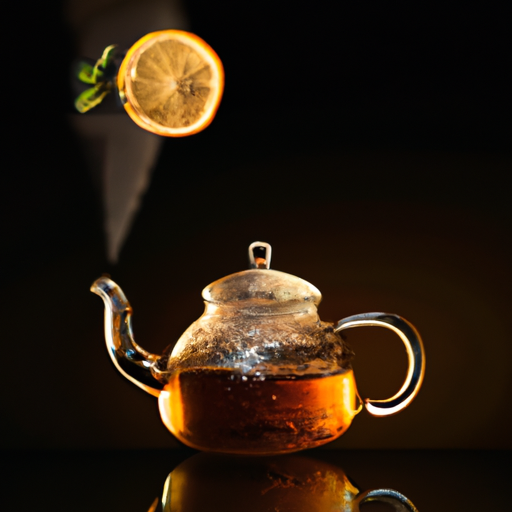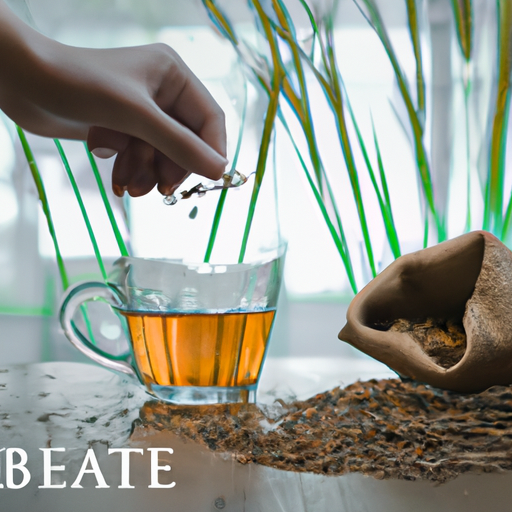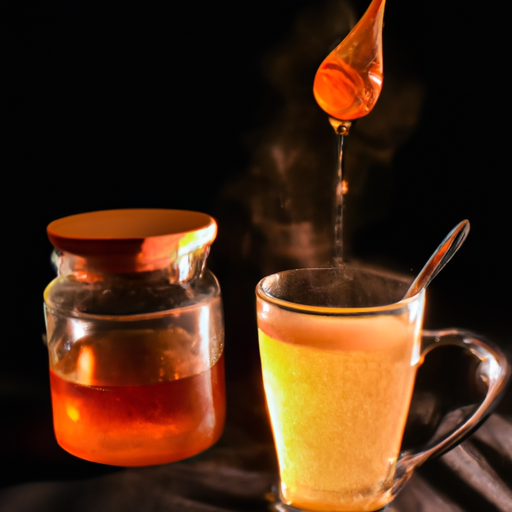Were you aware that in Korea, barley tea is the tea that’s consumed the most? Indeed, its popularity is such that it typically comes as the standard beverage in Korean eateries. Being a person who appreciates sipping on a hot tea, I’ve lately delved into the realm of barley tea and have been trying out various additions to improve its taste.
Barley tea, also known as roasted barley tea or mugicha in Japanese, is made from roasted barley grains and has a nutty, slightly bitter taste. It contains no caffeine and is high in antioxidants, making it a great alternative to traditional caffeinated teas. While it’s delicious on its own, adding mix-ins can take your cup of barley tea to the next level.
In this article, I’ll be sharing some of my favorite mix-ins for barley tea that are easy to find at any grocery store.
Key Takeaways
- Barley tea is a popular and refreshing beverage in Korea, made from roasted barley grains with a nutty and slightly bitter taste.
- Mix-ins like ginger, cinnamon, turmeric, lemon, mint, and honey can enhance the taste and provide health benefits, such as aiding digestion, reducing inflammation, and promoting weight loss.
- Barley tea is naturally caffeine-free and high in antioxidants, making it an ideal alternative to sugary drinks and suitable for those sensitive to caffeine.
- Regular consumption of barley tea with mix-ins can promote gut health, lower levels of inflammatory markers in the blood, and maintain healthy eyesight.
The Basics of Barley Tea
You’ll want to learn the basics of barley tea, as it’s a popular and refreshing beverage that can be enjoyed hot or cold. Exploring the history, production, and cultural significance of barley tea is a good starting point.
In Asia, especially in Japan and Korea, barley tea has been enjoyed for centuries. It is made by roasting barley grains until they turn brown before brewing them in hot water.
Barley tea, also known as mugicha in Japan and boricha in Korea, has a nutty flavor that makes it a great alternative to coffee or black tea. Unlike other teas that contain caffeine, barley tea is naturally caffeine-free. This makes it an ideal drink for those who are sensitive to caffeine or looking for a healthy alternative to sugary drinks.
Comparing the nutritional benefits of barley tea to other popular tea varieties reveals that it contains vitamins B1 and B3 as well as minerals such as calcium and magnesium. These nutrients help with digestion, promote bone health, lower blood pressure levels, and reduce stress levels.
With its numerous health benefits and delicious taste, you’ll definitely want to try out this refreshing drink! Speaking of which, adding some lemon slices can enhance its flavor even further without adding any calories or sugar.
Lemon
When it comes to mixing barley tea, I love adding a slice of lemon for that refreshing citrus flavor.
Not only does it enhance the taste of the tea, but lemons are also a great source of Vitamin C which is essential for boosting immunity and fighting off infections.
Plus, lemons add a natural sweetness that eliminates the need for added sugars or artificial sweeteners.
Citrus Flavor
Adding a slice of lemon or orange to your barley tea creates a refreshing citrus twist. Citrus flavors are known for their ability to enhance the taste of different beverages, and barley tea is no exception.
Lemon, in particular, pairs well with the nutty taste of barley and adds a tangy kick that balances out the drink’s earthy flavor. Alternatively, you can also try adding lime or grapefruit slices for a more exotic twist.
When it comes to flavor combinations, brewing tips are essential to ensure that you get the most out of your drink. To infuse citrus flavors into your barley tea, add sliced lemons or oranges when brewing the tea leaves. Let them steep for 5-10 minutes before removing them from the pot or cup. This way, you’ll have a deliciously flavored beverage without overpowering its natural taste.
Incorporating citrus fruits into your barley tea not only adds flavor but also provides a vitamin C boost that’s good for your health. Vitamin C helps improve immunity and is an excellent antioxidant that helps reduce inflammation in the body. So why not enjoy a refreshing glass of citrus-infused barley tea while reaping its numerous health benefits?
Vitamin C Boost
Get ready to give your immune system a boost with the vitamin C found in citrus fruits! Barley tea is already a healthy drink on its own, but adding some citrus fruits can take it up a notch. Not only do they add flavor, but they also provide an additional source of vitamin C which can help improve your body’s defense against sickness.
Here are some easy recipes to incorporate citrus into your barley tea:
| Citrus Fruit | Recipe |
|---|---|
| Lemon | Squeeze fresh lemon juice into your barley tea and stir in honey for sweetness. Add ice cubes for a refreshing summer drink. |
| Orange | Cut up slices of orange and add them to your barley tea for a sweet and tangy taste. You can also try adding cinnamon sticks or cloves for extra flavor. |
| Grapefruit | Slice grapefruit into wedges and place them in the bottom of a glass. Pour barley tea over the fruit and let it steep for 5 minutes before serving. |
Benefits beyond vitamin C: exploring Subtopic
Moving onto our next subtopic, let’s explore how natural sweetness can enhance the taste of barley tea without relying on sugar or artificial sweeteners.
Natural Sweetness
Enhance the flavor of your barley tea with natural sweetness that doesn’t rely on sugar or artificial sweeteners. Natural sweeteners, like fruit pairings, can provide a subtle and refreshing taste to your drink.
Some popular fruits to mix with barley tea include lemon, lime, grapefruit, and orange slices. These fruits not only add flavor but also provide vitamin C. When it comes to fruit pairings, the possibilities are endless. You can try adding sliced strawberries or raspberries for a fruity and fragrant twist. Alternatively, you may opt for more exotic fruits like pineapple or mangoes for a tropical punch.
The best part about using fruit as a natural sweetener is that it’s low in calories and high in nutrients! For those who prefer something sweeter than fruit alone, honey is an excellent alternative to sugar and artificial sweeteners. It has numerous health benefits, such as anti-inflammatory properties and antibacterial effects on the body. Plus, its unique flavor adds depth to any drink without overpowering it.
Honey
Honey is definitely the perfect complement to barley tea for those who like a touch of sweetness in their drinks. There are various types of honey available, and each one has its unique flavor profile. Some popular options include clover honey, wildflower honey, and manuka honey. However, it’s important to choose raw or organic honey that hasn’t been processed as it contains more nutrients than regular commercial honey.
Adding honey to barley tea not only enhances its taste but also provides several health benefits. Honey is known for its antibacterial properties and can help soothe sore throats and coughs. It’s also rich in antioxidants that protect the body from damage caused by free radicals.
Moreover, consuming honey may improve digestion and boost energy levels due to its natural sugars.
Moving on to the next ingredient, ginger is another excellent addition to barley tea that adds a spicy kick with numerous health benefits.
Ginger
I love adding ginger to my barley tea because it gives it a spicy kick. Not only does it add flavor, but ginger also has digestive benefits, helping to soothe upset stomachs and aid in digestion.
Ginger is also known for its anti-inflammatory properties, making it a great addition to any diet for overall health and wellness.
Spicy Flavor
If you’re feeling adventurous, try mixing some red pepper flakes or cayenne pepper with your barley tea for a fiery kick. Not only will it give your drink a spicy flavor, but it also has potential health benefits. Spicy teas have been gaining popularity as a natural way to boost metabolism and aid digestion. There are several spicy tea alternatives that you can try out, including ginger, cinnamon, and turmeric blends.
To make things easier, I’ve created a table below with creative spice blends that you can mix with your barley tea for a flavorful experience. Experimenting with different spices not only adds variety to your daily routine but also provides an opportunity to explore new tastes and discover which ones work best for you. So go ahead and spice up your barley tea today!
| Spice Blend | Benefits | Recommended Serving |
|---|---|---|
| Cinnamon | Anti-inflammatory | 1/2 teaspoon |
| Turmeric | Antioxidant | 1/4 teaspoon |
| Cardamom | Digestive Aid | 1/4 teaspoon |
| Cloves | Anti-bacterial | 2-3 whole cloves |
Adding spices to our diet is an easy way to improve overall well-being. In the next section, we’ll delve into the digestive benefits of barley tea and how it can support gut health.
Digestive Benefits
Enhance your gut health by exploring the digestive benefits that come with adding spices to your daily routine. Barley tea and gut health go hand in hand, as barley is known for its high fiber content that promotes healthy digestion. By incorporating barley tea into your diet, you can maximize its digestive benefits.
Here are five ways to enhance the digestive benefits of barley tea:
- Add ginger to your barley tea: Ginger has anti-inflammatory properties and can help soothe an upset stomach.
- Include cinnamon sticks: Cinnamon is known for its ability to regulate blood sugar levels and reduce inflammation in the gut.
- Sprinkle some fennel seeds: Fennel seeds have been used for centuries as a natural remedy for bloating and indigestion.
- Mix in some turmeric powder: Turmeric contains curcumin, which is a potent anti-inflammatory agent that can help reduce gut inflammation.
- Squeeze fresh lemon juice: Lemon juice helps stimulate the production of gastric juices, which aid in digestion.
By incorporating these spices into your barley tea routine, you can boost its already impressive digestive benefits.
Moving on from digestive benefits, let’s explore how barley tea’s anti-inflammatory properties can benefit overall health.
Anti-Inflammatory Properties
Like a superhero’s shield, the anti-inflammatory properties of this delicious brew have the power to protect your body from harmful inflammation. Drinking barley tea regularly can help reduce chronic inflammation, which is linked to various health issues such as heart disease and cancer. Incorporating barley tea into your daily routine is an easy way to boost your immune system and improve overall health.
To make the most of its anti-inflammatory benefits, it’s best to drink barley tea in the morning or afternoon. This will allow your body to absorb its nutrients and antioxidants throughout the day, providing protection against inflammation. You can also mix it with different herbs or fruits like lemon or ginger for added flavor and health benefits.
Overall, adding barley tea into your daily routine can be a simple yet effective step towards a healthier lifestyle. As we move on to discussing mint as a potential ingredient for mixing with barley tea, it’s important to note that incorporating this herb can add even more health benefits to your cup of tea.
Mint
Mint is the perfect addition to barley tea, adding a refreshing and cool flavor that complements the nuttiness of the tea. Here are three reasons why I love mixing mint with my barley tea:
-
Benefits of mint in other beverages: Mint has long been used for medicinal purposes due to its anti-inflammatory properties. When mixed with barley tea, it not only adds flavor but also provides a variety of health benefits. Mint can help improve digestion, relieve stress, and even freshen breath.
-
Different ways to prepare mint barley tea: There are many different ways to prepare mint barley tea depending on your taste preferences and desired level of sweetness. Some people like to add honey or lemon for extra flavor, while others prefer it plain. You can also try brewing the tea with fresh mint leaves or adding dried leaves after steeping.
-
Versatility: Mint barley tea can be enjoyed hot or cold, making it a versatile drink for any time of day or season. In the summer months, try pouring the brewed tea over ice for a refreshing iced beverage. During colder months, enjoy it hot as a comforting drink before bed.
Moving on to our next topic about cinnamon…
Cinnamon
I personally enjoy adding cinnamon to my barley tea for its warm and spicy flavor. Not only does it enhance the taste, but it also has potential health benefits. Research suggests that consuming cinnamon may improve insulin sensitivity and reduce inflammation in the body, making it a great addition to your daily diet.
Cinnamon is known to regulate blood sugar levels and provide antioxidant properties. So, it’s a perfect ingredient to add to your tea. Plus, it has a delicious flavor that can make your drink even more enjoyable. So, don’t hesitate to sprinkle some cinnamon on your tea and enjoy its benefits!
Warm and Spicy Flavor
Adding a touch of cinnamon to your barley tea might sound unusual, but trust me when I say that the warm and spicy flavor is worth trying. Not only does cinnamon add an extra layer of complexity to your beverage, but it also has numerous health benefits.
Cinnamon is known for its anti-inflammatory properties and its ability to regulate blood sugar levels. If you’re looking for other spice blends or tea pairings to try with your barley tea, ginger and cardamom are great options as well.
Ginger adds a slightly sweet and pungent taste while cardamom provides a floral and spicy aroma. Experiment with different combinations to find the perfect balance for your taste buds.
Speaking of blood sugar regulation, did you know that drinking barley tea may help improve insulin sensitivity? Let’s dive into how this works in the next section.
Blood Sugar Regulation
Explore the health benefits of cinnamon and other spice blends in your barley tea, as they can regulate blood sugar levels and improve insulin sensitivity. Balancing blood sugar is crucial for overall health, especially for individuals with diabetes or those at risk of developing it. Adding a few dashes of cinnamon or other spices to your barley tea can offer a natural way to help control blood sugar levels.
Incorporating dietary recommendations that include various spices in your diet can be beneficial. Here’s an example table showcasing the glycemic index (GI) values of some common spices:
| Spice | GI Value |
|---|---|
| Cinnamon | 5 |
| Ginger | 0 |
| Turmeric | 0 |
As shown in the table, cinnamon has a low GI value, indicating its potential to help regulate blood glucose levels. Ginger and turmeric are also known for their anti-inflammatory properties which may potentially benefit individuals with diabetes. Overall, incorporating spices into your daily diet can have a positive impact on balancing blood sugar levels.
Moving forward to the next section about ‘antioxidant properties’, we will explore how adding certain ingredients like lemon or honey to your barley tea can enhance its nutritional value without compromising taste.
Antioxidant Properties
Enhance the nutritional value of your barley tea by exploring the benefits of incorporating ingredients like lemon or honey. These can provide antioxidant properties that combat free radicals and promote overall health. Antioxidants are compounds that protect cells from damage caused by free radicals. These are unstable molecules that can cause oxidative stress in the body. By adding lemon or honey to your barley tea, you can increase its antioxidant content and boost its ability to fight off harmful toxins.
Here are three other teas you may want to consider combining with your barley tea for added antioxidant benefits:
-
Green Tea: This well-known tea is packed with antioxidants called catechins. These have been shown to reduce inflammation and improve heart health.
-
Ginger Tea: Ginger contains a powerful antioxidant called gingerol. This has been linked to improved digestion and reduced inflammation.
-
Rooibos Tea: Rooibos is a red herbal tea that is naturally caffeine-free and rich in antioxidants like aspalathin, quercetin, and chrysoeriol.
Moving on to our next ingredient – cardamom!
Cardamom
I love adding cardamom to my barley tea because it has a rich and spicy flavor that complements the nutty taste of the tea.
Not only does it enhance the taste, but cardamom also boasts several health benefits such as aiding in digestion and having anti-inflammatory properties.
According to studies, this spice contains compounds that can help alleviate digestive issues like bloating, gas, and constipation while reducing inflammation in the body.
Rich and Spicy Flavor
Dare to add a hint of fiery ginger or a dash of cinnamon to your barley tea for a bold and zesty kick. The rich and spicy flavor of these ingredients pairs perfectly with the nutty notes of barley tea, creating a unique taste experience.
Here are five creative blends you can try:
- Turmeric: This spice adds warmth and earthiness to your barley tea. It also has anti-inflammatory properties that may benefit your health.
- Black pepper: A pinch of black pepper will give your barley tea a subtle heat that complements its nuttiness.
- Cayenne pepper: If you’re feeling brave, add a tiny bit of cayenne pepper for an intense kick. This spice is also known for its digestive benefits.
- Cloves: These fragrant buds lend a warm and sweet flavor to your barley tea. They may also have antimicrobial and antioxidant properties.
- Star anise: This star-shaped spice has a licorice-like flavor that pairs well with the nuttiness of barley tea. It’s also rich in antioxidants.
Adding these spices not only enhances the taste but provides health benefits as well.
Speaking of which, did you know that adding certain herbs and spices to your diet can promote better digestion? Let’s explore some digestive benefits next…
Digestive Benefits
After indulging in the rich and spicy flavor of barley tea, it’s important to consider its digestive benefits.
Barley tea has been used for centuries as a natural remedy for digestive issues such as bloating, constipation, and diarrhea. It contains compounds that promote gut health by reducing inflammation and improving digestion.
One of the most notable benefits of barley tea is its ability to aid in weight loss. Studies have shown that drinking barley tea can help reduce body weight and BMI by increasing metabolism and decreasing appetite. Its high fiber content also helps regulate blood sugar levels, which can prevent overeating and cravings.
As we move on to discussing the next subtopic about the anti-inflammatory properties of barley tea, it’s important to note that these benefits are all interconnected. By improving gut health and aiding in weight loss, barley tea can ultimately lead to reduced inflammation throughout the body.
Anti-Inflammatory Properties
You’ll be pleased to know that the anti-inflammatory properties of this delicious beverage are yet another reason to add it to your daily routine. Barley tea has been found to contain compounds that have potent anti-inflammatory effects, making it a great addition to any diet aimed at reducing inflammation in the body. In fact, scientific research has shown that regularly consuming barley tea can help lower levels of inflammatory markers in the blood and improve overall health.
If you’re looking for recipes with barley tea for reducing inflammation, there are plenty of options available. One popular recipe is simply boiling barley tea leaves with ginger and honey for a soothing and anti-inflammatory drink. Another option is adding fresh mint leaves and lemon slices to cold brewed barley tea for a refreshing twist on this healthy beverage. With so many possibilities, incorporating barley tea into your daily routine is both easy and beneficial for your health. Speaking of which, let’s move on to our next ingredient: chrysanthemum!
Chrysanthemum
I’m excited to discuss chrysanthemum as a tea ingredient because it offers a unique floral flavor that’s both refreshing and soothing.
Not only does this flower add a lovely taste to beverages, but it also has cooling properties that make it an excellent choice for hot summer days.
Additionally, chrysanthemum is known for its eye health benefits and has been used in traditional Chinese medicine for centuries to improve vision and reduce eye strain.
Floral Flavor
Indulge in the delicate taste of a garden by adding a splash of honey and a few drops of lavender oil to your barley tea.
Floral flavors have long been used in beverages, with herbs like chamomile, rose, and jasmine being popular choices for adding an aromatic touch to teas.
Incorporating floral herbs into tea blends not only adds flavor but also offers potential health benefits as well.
Lavender is known for its calming properties, making it an ideal addition to any tea blend.
Honey adds a touch of sweetness that complements the floral notes of the lavender perfectly.
This combination creates a soothing drink that can help you relax after a long day or provide some comfort during times of stress.
Moving on from these floral notes, let’s explore how barley tea can offer cooling properties when served cold.
Cooling Properties
To experience a refreshing sensation on a scorching day, sip on a chilled glass of barley tea infused with cooling properties. Not only is this beverage a great thirst quencher, but it also helps to cool down the body temperature. The addition of mint leaves or lemon slices to the tea enhances its cooling effect and creates a pleasant taste.
Apart from being an ultimate summer drink, barley tea with cooling properties brings benefits for skin health as well. Traditionally, it’s been used in Korean and Japanese cultures to soothe sunburns and reduce inflammation. The antioxidants present in barley tea help prevent premature aging and protect the skin against environmental damage.
With all these benefits combined, drinking barley tea with cooling properties can be beneficial for both internal and external health. Moving onto our next section about eye health benefits…
Eye Health Benefits
You can improve your vision and protect your eyes by incorporating a refreshing beverage that’s been enjoyed for centuries in Asian cultures. Barley tea isn’t only known for its cooling properties, but it also contains nutrients that support eye health.
The tea is rich in antioxidants such as lutein and zeaxanthin, which are essential for maintaining healthy eyes. In addition to drinking barley tea, you can also perform eye exercises and take nutritional supplements to improve your eye health.
Eye exercises help strengthen the muscles around the eyes and improve circulation, while supplements such as omega-3 fatty acids and vitamin A provide essential nutrients for optimal eye function. Incorporating these habits into your daily routine can greatly benefit your overall eye health.
Speaking of nutrition, let’s move on to another ingredient that pairs well with barley tea: citrus peel.
Citrus Peel
Adding citrus peel can give your barley tea a refreshing twist, as one medium-sized orange contains about 50% of your daily recommended intake of vitamin C. Not only does it enhance the flavor, but it also provides numerous health benefits.
Citrus peel is packed with antioxidants that protect against inflammation and cell damage, improving overall health. Using citrus peel in other tea blends is also a great way to reap its benefits. Lemon and lime peels are commonly used in herbal teas for their refreshing taste and immune-boosting properties.
Orange peel can be added to black tea for a zesty kick or combined with ginger for a warming blend. Exploring the health benefits of citrus peel beyond flavor is crucial. Studies have shown that compounds found in citrus peels may help lower cholesterol levels, prevent cancer, and aid digestion.
The high amount of fiber in the peels can also promote feelings of fullness and reduce appetite, aiding weight loss efforts. By adding citrus peel to your barley tea or experimenting with mix-ins like lemon or lime peels, you not only add depth and complexity to your drink but also boost its nutritional value.
Up next, let’s dive into some exciting mix-ins you can try to take your barley tea game up a notch!
Experimenting with Mix-Ins
I’ve always been a fan of experimenting with different flavors when it comes to my favorite beverages. So when I discovered the versatility of barley tea, I knew I had to try mixing it with unexpected ingredients that would complement its unique taste.
Mixing barley tea with citrus peels was just the beginning for me. I began exploring other mix-ins based on different occasions and moods.
For example, adding mint leaves and lemon slices made for a refreshing summer drink, while cinnamon sticks and honey created a cozy winter beverage.
The possibilities are endless when it comes to mixing in flavors with barley tea. Whether you’re looking for a healthy alternative to sugary drinks or simply want to switch up your daily routine, give barley tea mix-ins a try – you might just be surprised at how delicious they can be!
Frequently Asked Questions
What are the health benefits of barley tea?
As someone interested in health and wellness, I’ve researched the benefits of barley tea.
It turns out that drinking barley tea may aid in weight loss as it contains compounds that regulate blood sugar levels and reduce appetite.
Additionally, this tea has been found to improve digestion, boost immune function, and lower cholesterol levels.
For those looking to incorporate barley tea into their diet, there are a variety of recipes online, including iced versions with lemon or honey.
However, it’s important to note that while drinking barley tea can be beneficial for overall health and well-being, it shouldn’t be used as a substitute for medical treatment.
How do you properly brew barley tea?
Did you know that barley tea, also known as Mugicha, is one of the most popular drinks in Japan and Korea? It’s no surprise considering its many health benefits.
Now, let’s talk about how to properly brew this delicious tea. Tips for steeping barley tea include using a teapot or strainer to avoid bits of barley floating in your cup and adding hot water just before boiling to prevent bitterness.
As for variations of barley tea blends, you can mix it with other ingredients like lemon or honey for added flavor. Overall, brewing barley tea is simple but following these tips will ensure a perfect cup every time!
Can you mix barley tea with milk or cream?
Yes, you can mix barley tea with milk or cream. However, it’s not common to do so. Barley tea is a popular non-alcoholic drink in East Asian countries. It has a nutty and slightly sweet flavor, which can be enhanced with honey or other natural sweeteners.
Mixing milk or cream with barley tea may change its taste and texture, but it depends on personal preference. If you decide to add milk or cream, make sure to adjust the amount of sweetener to avoid overpowering the tea’s natural flavor.
What are some common flavor profiles associated with barley tea?
Barley tea has a unique flavor that can be described as nutty and toasty, like roasted grains. It is often enjoyed on its own, but there are also many savory pairings and sweet combinations that work well with this tea.
Some common savory pairings include grilled meats, stews, and soups, while sweet combinations might include honey or brown sugar. Additionally, barley tea can be mixed with other teas such as green or black tea for a more complex flavor profile.
However, it’s important to note that the natural flavors of barley tea should be appreciated on their own before considering any additional mix-ins.
Is there a particular time of day or season when barley tea is best enjoyed?
In my experience, there isn’t necessarily a specific time of day or season when barley tea is best enjoyed. However, I do believe that the best brewing methods can vary depending on personal preferences and cultural significance.
For example, in Japan, barley tea (or mugi-cha) is often enjoyed cold during the summer months as a refreshing beverage. On the other hand, some people prefer to drink it hot year-round for its soothing properties.
As for brewing methods, some people prefer to steep their barley tea in hot water for several minutes while others like to use a cold brew method for a lighter flavor. Ultimately, it’s up to individual taste and cultural traditions when it comes to enjoying this versatile beverage.
Conclusion
In conclusion, after trying out various mix-ins with barley tea, I can confidently say that there are so many options to choose from!
My personal favorites were lemon and honey, as they added a sweet and tangy flavor to the tea. Ginger and mint were also great choices for those who prefer a more refreshing taste.
However, don’t be afraid to experiment with your own mix-ins! Try adding cardamom or chrysanthemum for a unique twist on traditional barley tea. Citrus peel is another option that can add a subtle but delicious flavor to the drink.
The possibilities are endless when it comes to mixing in flavors with this classic beverage.
Overall, I highly recommend giving barley tea a try if you haven’t already, and don’t be afraid to get creative with your mix-ins! Who knows – you may discover your new favorite drink combination.
So go ahead and grab some ingredients from your pantry – let the mixing begin!










